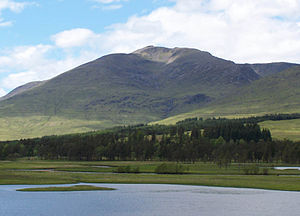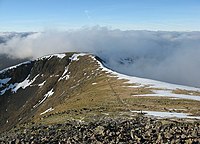Stob Ghabhar
| Stob Ghabhar | |
| Argyllshire | |
|---|---|
 Stob Ghabhar across Loch Tulla | |
| Summit: | 3,576 feet NN230455 56°34’5"N, 4°52’57"W |
Stob Ghabhar is a mountain in Argyllshire, 5½ miles north-west of Bridge of Orchy. It reaches a height of 3,576 feet at its summit, and is listed as a Munro.
Overview
Stob Ghabhar is well seen from the east and is a familiar sight to motorists on the A82 road as it skirts the western edge of Rannoch Moor. The mountains eastern corries formed by the headwaters of the River Ba look impressive from this direction as does the neighbouring mountain of Stob a' Choire Odhair with which Stob Ghabhar is usually climbed.
The mountain reaches a height of 3,576 feet and qualifies as a Munro and a "Marilyn". The mountain's name translates from the Gaelic language as "Goat's Peak".[1] Goats were often encouraged by shepherds on mountains with precipitous cliffs such as Stob Ghabhar to keep sheep away from the steep drops.
Geography
Summits
- Stob Ghabhar main summit NN230455, 3,576 feet
- Subsidiary tops:
Shape of the mountain
Stob Ghabhar is regarded as the finest of the four Munros of the Black Mount (the others being Stob a' Choire Odhair, Creise and Meall a' Bhuiridh), it is a large and impressive mountain with long ridges radiating from it prominent pointed summit and deep scalloped corries on its flanks. The three main ridges go east, west and north-west from the highest point and have on them four lesser peaks which are listed as "tops" in the Munro Tables.
The east ridge goes over Aonach Eagach before continuing to the adjoining Munro of Stob a' Choire Odhair.
The western ridge is initially narrow as it traverses the crest of two opposing corries before reaching Sròn a' Ghearrain after less than a mile.
Stob a' Bhruaich Leith is a mile further along the ridge, which then drops down gradually towards Glen Etive.
Sròn nan Giubhas is 750 yards north of the main summit along a ridge which then swings northwest and descends for three miles to Glen Etive.[2]
Stob Ghabhar's other notable geographical features are its corries and cliffs. Coire Dhearbhadh which stands on the mountain's eastern flank is ringed by sheer cliffs and contains the small lochan, Coirein Lochain. The steep headwall of this corrie contains the upper couloir, a deep gully which provides a tough scrambling route to the summit in summer and a classic ice route in winter which was first climbed in 1897.[3] The summit stands on the edge of the cliffs overlooking the corrie.
Two other large corries stand to the west of the summit, Coire a' Chaolain on the northern side of the west ridge and Coire Ghabhar on the southern side, these two corries almost touch and make the ridge quite narrow. Drainage from the mountain finds its way to both the east and west coasts of Scotland, the northern slopes drain via the River Etive and Loch Etive to the west coast near Oban. Water from the southern slopes goes to the same place but progresses by Glen Orchy and Loch Awe while the eastern slopes drain via Loch Rannoch and the River Tay to the east coast at the Firth of Tay. The whole of the Black Mount range is noted for the complexity of its geology, there is a junction of gneiss and Cruachan granite near the summit of Stob Ghabhar.[4]
Duncan Ban MacIntyre
Duncan Ban MacIntyre (1724–1812) one of the greatest Gaelic poets, was born in the southern foothills of Stob Ghabhar at the croft of Druim Liaghart near Victoria Bridge. MacIntyre, whose birthplace is marked by a plinth, worked as a forester and gamekeeper in the area until 1767 when he moved to Edinburgh.
Much of his poetry was concerned with the flora, fauna and mountains of the area.[5][6]
Ascents
The ascent of Stob Ghabhar is usually combined with the adjoining Munro of Stob a' Choir' Odhar[7] and the starting point for this walk is the car park at Victoria Bridge at the western end of Loch Tulla at grid reference NN269419. The West Highland Way is followed for a short distance until a track is taken west along the north bank of the River Shira as far as the Clashgour hut which belongs to the Glasgow University Mountaineering Club (but which before 1933 was the local primary school).[8] At the hut turn right (north) by the Allt Toaig for two kilometres before ascending onto the Aonach Eagach ridge which leads to the summit.
Stob Ghabhar can be climbed by strong walkers as part of the complete traverse of the Black Mount range. This classic walk is a long hard journey of 15 miles between the Kings House Hotel at the eastern end of Glencoe and the Inveroran Hotel near Bridge of Orchy, it has 5,500 feet of vertical ascent and never drops below the 730 metre contour. Transport can be a problem and needs to be organised at both ends.[9] The highlight of the view from the summit is an excellent prospect of Rannoch Moor to the east while the Glen Coe and Etive mountains are well seen to the north and west.
References

- The Munros, Scottish Mountaineering Trust, 1986, Donald Bennett (Editor) ISBN 0-907521-13-4
- In the Hills of Breadalbane, V.A. Firsoff, no ISBN
- The Munros, Scotland's Highest Mountains, Cameron McNeish, ISBN 1-84204-082-0
- The Magic Of The Munros, Irvine Butterfield, ISBN 0-7153-2168-4
- Hamish's Mountain Walk, Hamish Brown, ISBN 1-898573-08-5
- ↑ All above reference books give this translation.
- ↑ Database of British and Irish Hills; The Munros and Tops 1891-1997. Downloadable database and table showing changes through successive editions of Munro's Tables.
- ↑ Glasgow Digital Library. Gives details of early attempts on the upper couloir.
- ↑ "The Central Highlands" Page 46 Gives details of geology.
- ↑ www.slainte.org.uk. Gives info on Duncan Ban McIntyre.
- ↑ Information board on Black Mount Estate gives info on Duncan Ban McIntyre.
- ↑ "The Munros" Page 50 (Gives info on circular route from Victoria Bridge).
- ↑ Glasgow University Mountaineering Club website. Gives details of Clasgour Hut.
- ↑ "100 Best Routes on Scottish Mountains" Pages 50 (Gives info on Black Mount traverse).
| Munros in SMC Area SMC Section 3 - Strath Orchy to Loch Leven |
|---|
|
Beinn a' Chochuill • Beinn Eunaich • Beinn Fhionnlaidh • Beinn nan Aighenan • Beinn Sgulaird • Ben Cruachan • Ben Starav • Bidean nam Bian • Buachaille Etive Mòr • Creise • Glas Bheinn Mhòr • Meall a' Bhuiridh • Meall Dearg, Argyll • Meall nan Eun • Sgor na h-Ulaidh • Beinn a' Bheithir • Beinn a' Bheithir • Sgorr nam Fiannaidh • Stob a' Choire Odhair • Stob Coir'an Albannaich • Buachaille Etive Beag • Stob Coire Sgreamhach • Stob Diamh • Buachaille Etive Beag • Stob Ghabhar • Buachaille Etive Mòr |